Written by Richard McChesney - http://richardwalkslondon.com/
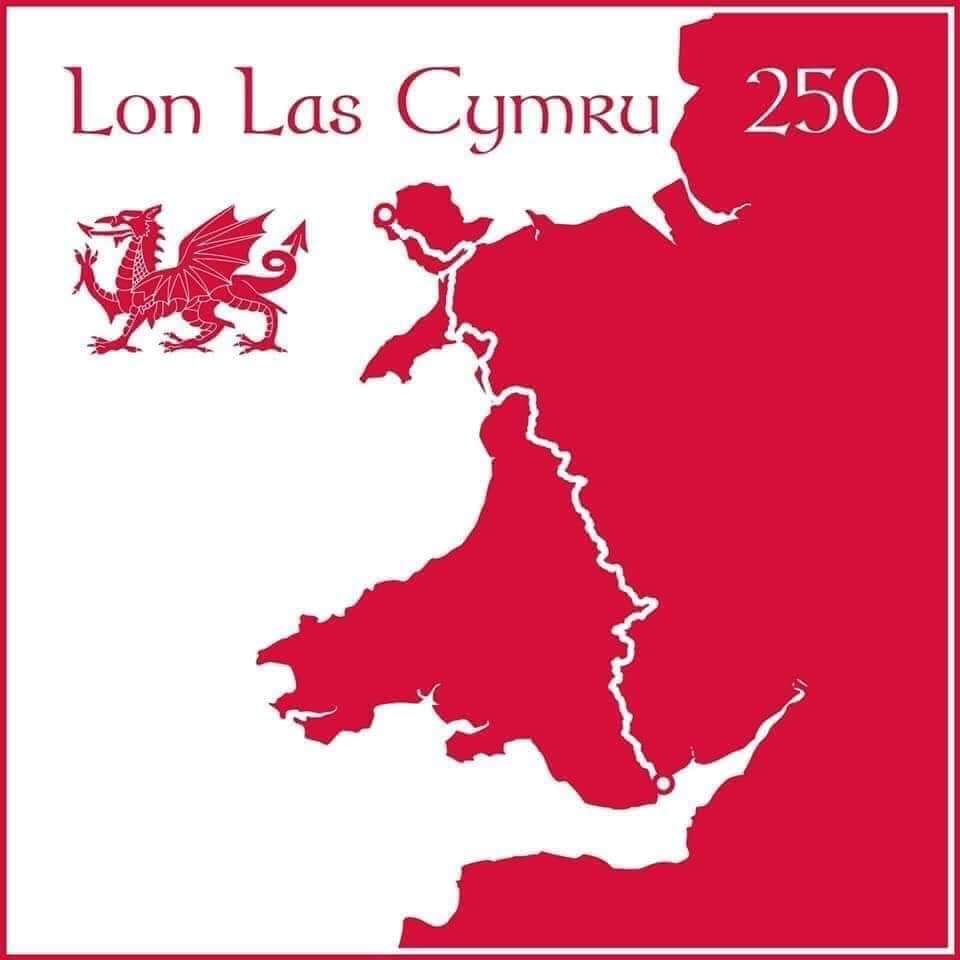
“I don’t remember there being a castle in Adelaide” I thought to myself as I realised I was walking beside a castle having found my way on to a road after being unable to exit Bute Park in Cardiff due to a locked gate just a few miles from the finish of the Lon Las Ultra.
Having spent the last almost 90 hours walking to Cardiff, for some strange reason I thought I was in Adelaide (Australia). And on reviewing the course map while writing this race report, I also realise that I shouldn’t have been in Bute Park anyway but should have crossed over the River Taff a mile or so earlier.
The Lon Las Ultra is a 253 mile (407km) running race from Holyhead in Northwest Wales to Cardiff in Southeast Wales. It follows an almost diagonal line across the country climbing in excess of 5,500 metres and dropping the same – starting and finishing at sea level. It is supposedly a national cycle route but some of the hills are so steep, going both up and down, that I can’t imagine anyone cycling it – although apparently people do.
The 2021 edition was the third running of the Lon Las Ultra and to date only nine runners had finished the challenge. I attempted it in 2019 – the year of the horizontal rain – and only managed about 140 miles before dropping out mainly due to being cold and wet, but also due to lacking the mental strength to complete the event.
2021 would be different!
Holyhead to Criccieth – 0 to 60 miles
Unlike 2019 we woke up to a mild day and 29 runners assembled beside the railway station in Holyhead just before 7am for race director Mark Cockbain’s inspirational pre-race briefing – something about “… most of you won’t finish …” – and a pre-race photo.
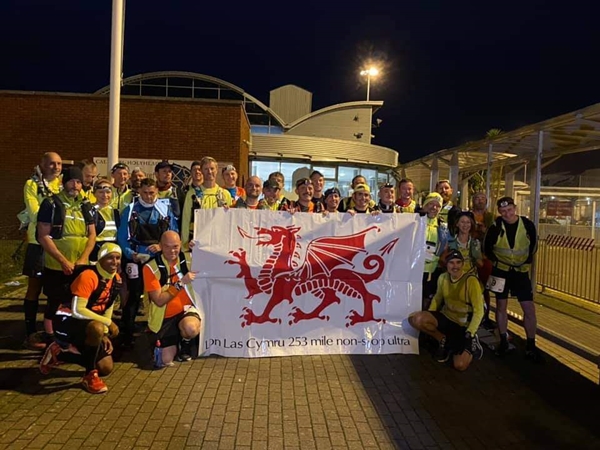
I set out at a comfortable pace at the back of the field. As usual I was the only walker in a field of runners and whilst I expected to catch some of the runners during the next 3 ½ days, I had no intention of going too fast early on.
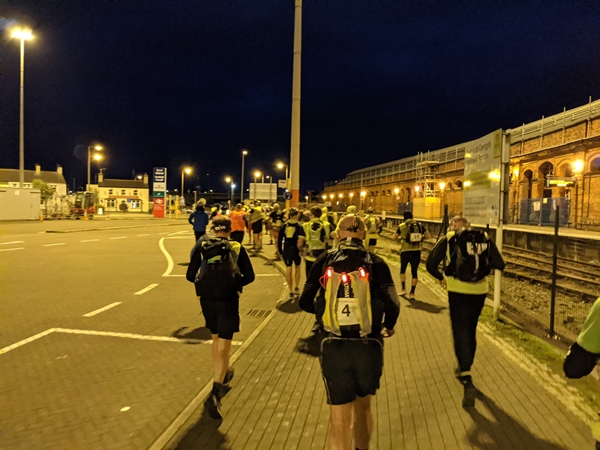
I was surprised therefore to find myself playing cat and mouse with a few runners during the morning and early afternoon. One of those runners was David Wright who I had spent a lot of time walking with during our 2019 attempt – David had dropped out at a similar place to me in 2019 after being found asleep in a ditch by a passing horse rider.
My pace through the morning was a very consistent 7km (4.35 miles) per hour and I arrived at the first checkpoint at Menai Bridge (31 miles) in 27th place just after 2pm. The Lon Las Ultra is a ‘self-supported’ event – meaning that not only are odd-numbered checkpoints outdoors but all you get at any checkpoint is water. Checkpoints 4, 6 and 8 (100, 150 and 200 miles) are indoors meaning that they are warm and you have the opportunity to sleep if you want/need to, but other than that the athletes are expected to fend for themselves.
I was in and out of the Menai Bridge checkpoint in about 4 minutes, just enough time to refill my water bottles and get some more food out of my race backpack and stuff it into my pockets, waistbelt, etc.
The first two legs were the longest of the race but also the easiest. No serious hills, not too tired (yet) and mostly in daylight. The only real highlight for me during the first day was the small town of Caernarfon which I arrived at around 4pm. In 2019 I had taken a short detour off the course at Caernarfon to buy McDonalds for an early dinner, but this year I decided that I would prefer Fish n Chips and used Google to identify all the local Fish n Chip shops. The one with the highest star rating was only a block off the race route so I decided that would be my dinner for today. When I arrived the door was open but the owner advised that they were closed until 4:30pm. I told him that I was in a race and couldn’t wait around, and I asked for his recommendation for another Fish n Chip. Not wanting to recommend his competition he suggested that I continue through to Criccieth, but I knew I wouldn’t get there for another five hours and I wanted food now. He said that there were plenty of Fish n Chip shops in the square, so I walked a short distance further and stopped at the first Fish n Chip I found – wrong choice!
The chips were great, but the fish wasn’t. I ate about half of the fish before binning it and ate the remaining chips while walking. I also bought a can of Coke but decided that I hadn’t yet walked far enough to drink Coke (usually preferring to stay off highly processed sugar until at least 12 hours into any race), so I put that in my backpack saving it for later.
‘Later’ was when I reached 50 miles, which I passed in a respectable 12 hours and 3 minutes. I had started to struggle a little and decided to reward myself with a can of Coke just as David Wright caught me up again. This was perfect. Between the Coke and the faster pace that David was running/walking I regained my enthusiasm and my pace immediately picked back up. David and I stayed together for most of the remaining ten miles through to checkpoint 2 which I arrived at at 9:19pm – 14 hours and 19 minutes after race start.
Criccieth to Dolgellau – 60 to 100 miles
The Criccieth checkpoint is at a bus stop beside the sea. Unlikely 2019 when it was wet and cold, the weather was still reasonable but knowing that we were heading up into the hills for the night, and with rain forecast, I put on some warmer clothes and replenished my backpack with my food for the next 40 miles. All up, I was at the checkpoint for about 15 minutes, leaving in 23rd position with three other runners just in front of me.
I love walking at night and really enjoyed the 20 miles through to checkpoint 3. Almost immediately upon leaving Criccieth there is a long steady climb before a descent into a town called Porthmadog (I love the Welsh names ) and soon after Porthmadog we hit the first really big climb of the race – a 250 metre climb over about 4 kilometres followed by an even steeper descent to checkpoint 3.
I really enjoyed the climb. My only regret being that it was dark, and we were missing what I expected were fantastic views. The rain stopped mid-way up the ascent, but rain was replaced by mist that made it difficult to see too far ahead. Not to worry, I seemed to negotiate the route without any problems and arrived at checkpoint 3 at 3:39am to find two runners suffering more than they should be at this stage of the race. Tom Garrod, especially. Tom was planning on doing a double Lon Las Ultra as a fundraiser for a cancer charity and with only 80 miles of over 500 completed so far, he was not in a happy place.
Having refilled my water bottles, I wasn’t planning of hanging around at the checkpoint and convinced Tom to walk with me, figuring that if he got moving and had me to talk to he would start feeling better. Unfortunately, we spent too much time focused on conversation and not where we were supposed to be going and we missed a turnoff soon afterwards. In the totality of the race, this didn’t matter but it did mean that we accidentally took a shortcut of about 1 ½ miles (2 ½ km). Something I felt guilty about for the rest of the race, once I became aware of it, even though I would more than make up the missed distance during the remaining days when I got lost on various occasions.
The miles flew by and soon we were walking through a small town at around 5 or 5:30am when we came across a shop with an open door. I think the shop was a sandwich shop, but I didn’t stop to check it out. Tom did however, and I kept walking catching up with Javed Bhatti a few minutes later. Javed had also stopped at the shop and confirmed that it was selling sandwiches. Javed is a hugely experienced ultra-distance runner, and I took the opportunity to pick his brain about my ongoing problems with sleep deprivation during long races.
Sometime after 6am I arrived at Barmouth from where we were diverted on to an A road heading inland towards Dolgellau. The race should have headed across a pedestrian bridge over the river but unfortunately the bridge was closed for maintenance, and we had to walk (run) along a semi-busy road without footpaths for the next 5 or 6 miles rather than the pedestrian trail on the other side of the river. I didn’t have any problems along this stretch, but Javed narrowly escaped being hit by a car and decided that that was enough for him – he withdrew from the race at the 60 mile checkpoint.
I started to struggle again during this stretch despite having drunk a bottle of Coke at Barmouth, and I decided that I would have my first sleep when I got to Dolgellau. The Dolgellau rugby club being our first indoor checkpoint and therefore our first opportunity to have a sleep in warm conditions, and our last opportunity until 150 miles. I arrived at Dolgellau at 8:53am (25 hours and 53 minutes after the start) but with only 157km on my watch – due to the shortcut I had taken and also the diversion meant that the 100 mile checkpoint was actually at 99 miles. I was now in 16th place. Not too bad, but a long way still to go.
Dolgellau to Rhayader – 100 to 150 miles
After sorting out my food, clothing, etc, I tried to sleep but I no longer felt tired, and both my hips were too sore for me to get comfortable enough to fall asleep. I lay in my sleeping bag for about 20 minutes before giving up and left the checkpoint after about 90 minutes total break.
Immediately after leaving the checkpoint the route heads up hill again, rising from near sea level to 425 metres in just five miles, and then dropping back to 100 metres just as quickly. I don’t particularly enjoy hills (major understatement) and for this reason I don’t spend anywhere enough time training on hills. And because of this, my quads and shins were really struggling with the downhills. I didn’t mind the ups, but the steep downhill sections were slower than the uphills.
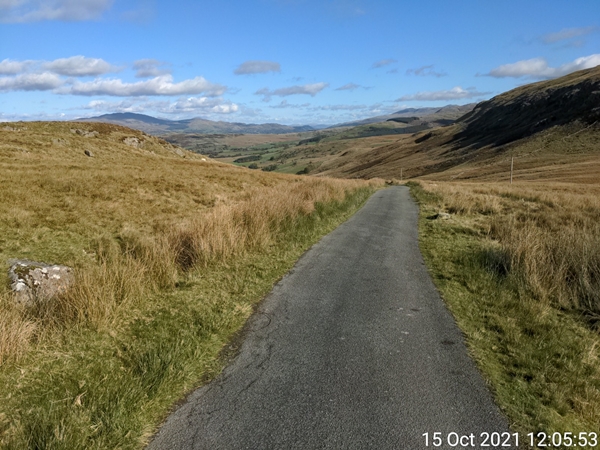
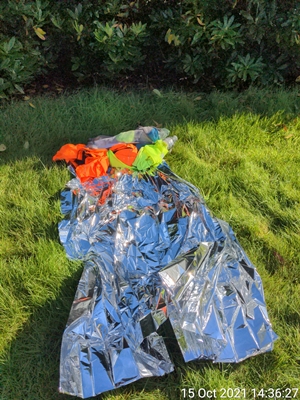
We walked together for a while but Steve was struggling and considering dropping out of the race. He decided to stop and have a rest and something to eat, leaving me to continue on alone.
Soon after, I think probably around 4pm’ish I stopped in a town called Machynlleth. Firstly I went to the Co-op to buy some painkillers in the hope that they would reduce the pain I was feeling in both my hips, and then further down the road I purchased a sausage and chips at the local Fish n Chip shop – the same shop I stopped at after my visit to the launderette during the 2019 race. As with 2019, they were the best sausage and chips I had eaten in years, and at only £2.90 I couldn’t believe the value for money!
I remembered Machynlleth from 2019 as being the start of the long climb up to the halfway point. The big difference this year was that I would be making that climb (from close to sea level up to 570 metres) in daylight and I was looking forward to seeing the views that I had missed last time.
I wasn’t disappointed either. Over the final mile or two to the top, every time I went around a corner I stopped to take a photo, and then around the next corner the view was even better, and I took another photo. I felt fantastic and really enjoyed the climb followed by the half hour descent through to checkpoint 4 and halfway.
By now it was getting dark again and I had a short break at checkpoint 5 to put some warmer clothes on and sort out my head torch and flashing taillights. It was 7:27pm. 36 ½ hours since the race started. A maximum of 51 ½ hours to complete the second half (plus a bit extra – halfway was really only 125 miles out of 253). That shouldn’t be a problem, especially with net downhill.
I continued to feel good after leaving checkpoint 5 as we (me and my legs) walked at a comfortable rate but a few hours later I started to struggle again, just as Steve caught me. I was glad to see that Steve had persevered and not dropped out during his bad patch earlier in the afternoon and I keyed off him to try and keep my pace up. I think Steve was struggling as much, or more, than me and I remember stopping to sit down for a short rest a couple times. On one of those occasions I found a chair outside what appeared to be an abandoned workshop and called Steve over telling him that there was another chair that he could sit on.
I was struggling with the cold though, and could only rest a few minutes at a time. At some stage soon after Steve decided to stop for a sleep and I continued on alone again. A while later I arrived at a main road at the top of a long hill climb. I checked the route map and discovered that I shouldn’t be there. I had missed a turnoff about 1km earlier and now had to descend back to join the correct route. When I got back to the turnoff Steve was just arriving. While he was rested and feeling good, I had just wasted over half an hour walking up and down a hill that I didn’t need to! But, I rationalised to myself, I had made up for my accidental shortcut from Friday morning.
I couldn’t stay with Steve. He was going too fast, and I was feeling terrible. At the halfway checkpoint I thought there would be a good chance of getting through to 150 miles around 2:30/3am – given the downhill nature of the 25 miles in between checkpoints, but I was walking slower and slower, resting more and more often, and the downhill was interspersed with frequent sharp uphill sections.
I started thinking about withdrawing from the race. Every muscle and tendon in my legs was in pain. I was not enjoying myself anymore. Before leaving home my wife had told me that a DNF wasn’t an option. “Either finish or don’t come home” she had told me before I left for Wales on Wednesday – half joking, half serious.
I started justifying my upcoming DNF. I had been struggling with injuries most of the year and had been forced to visit my osteopath less than a week ago due to the pain I had in my right hip which I assumed was caused by over-compensating for my piriformis injury in recent weeks – although I hoped it was just one of those nervous pre-race injuries that seem to arrive in the week before a race (and disappear as soon as the race starts).
I decided that I was so close to checkpoint 6 at 150 miles that I should at least walk through to there before making any decisions, and when I arrived at checkpoint 6 at 6:11am (47 hours and 11 minutes) I realised that with 247km on my watch (242km plus 5km of getting lost mileage) I had actually walked my second best 48 hour distance ever! And that was with over 3,500 meters of elevation change!
So I wasn’t going as badly as I thought I was. I was in 12th place, although there were only 15 of us left in the race – of 29 starters.
Rhayader to Llanfynnch – 150 to 200 miles
I slept for 80 minutes at Rhayader, my longest sleep of the race and bringing my total amount of sleep since the race started to about 100 minutes. I felt good when I woke up and after some mucking about sorting out clothing and food, I was on my way at almost exactly 9am.
I’m not too sure how much later, but it wasn’t too long before I became aware of the painful chaffing in an area just above the top of my legs. The further I walked, and the more I thought about it, the more painful it became. It wasn’t long before I was walking like John Wayne after ten hours on a horseback. I applied some Vaseline which I carry for occasions such as this, which fortunately are not very common, but that really didn’t make much difference. A Google search suggested that Sudocrem was what I needed and a couple very uncomfortable hours later I found myself in Builth Wells looking for relief. Firstly, I visited the local Co-Op but couldn’t find any lubricant of any sought. I purchased some Savlon antiseptic cream in case I didn’t have any success elsewhere, along with a couple banana’s and two small bottles of Coke. Not sure what the person behind the till thought with this stinky ‘runner’ in front of them buying an eclectic ‘range’ of products.
Further down the road I found a Boots pharmacy and they had just what I wanted/needed. Next, find a secluded spot to apply the relief – an alleyway just around the corner. Then a walk across the road to the local park where I rested for a few minutes while eating a banana and washing it down with 500ml’s of Coke.
The relief wasn’t immediate and I needed to apply more Sodocrem during the next hour, but soon I was back walking as if nothing was ever wrong.
I arrived at the 175 mile checkpoint at 5:25pm (58 hours 25 minutes since race start) in 12th place, almost two hours behind Steve and over two hours ahead of Andrew Nesbet and three hours ahead of Gordon Hughes and Vic Owens. I was feeling a little tired, but not sleepy and I was on my way again after a short stop to refill water bottles, etc.
That was at 5:25pm. A little while later, probably around 6:30pm (I remember that it was still daylight) I called my wife for my evening check-in call and remember telling her something along the lines of “…remember when we went cycling in Wales …” and then I remembered that we had never been to Wales (other than Cardiff) together, and we definitely hadn’t been cycling in Wales. I was going to tell her that I was in that place where people went to name their bikes. I’m not sure what that meant, but in my mind it was a magical place that cyclists took their new bikes on some kind of pilgrimage resulting in them being given a name for their bike.
I had only said a few words when I realised that I must be imagining things, but the strange thing was that while I talked to Ruth I ‘knew’ that I had been here before. In 2019 I had dropped out of this race at around 140 miles. There is no way that I had been to this part of Wales before.
I was conscious enough to know that this was some sort of hallucination brought on by sleep deprivation, but I couldn’t explain how I ‘knew’ that shortly we would take a sharp left turn followed by a sharp right turn soon after. In writing this race report, I suspect that I had reviewed the course route on my phone a few minutes earlier perhaps, which is how I ‘knew’ the course, but at the time I started thinking that perhaps some higher being was guiding me.
A while later I ‘knew’ that when I reach the end of this road there will be a large barn behind a brown fence on the left and a little later there will be a white bus stop on the right. I also ‘knew’ that the white bus stop was temporary and had been put there especially for the cyclists to rest in after they had named their bikes during their pilgrimage.
Sure enough, I passed the big barn and then soon I arrived at the bus stop where I decided to have a short sleep. I checked my watch (I can’t remember now what time it was) and woke up 14 minutes later.
And now it gets interesting. When I woke up I thought that was a really strange dream. I had dreamt that I was in a race in the middle of Wales, but I ‘knew’ I was in North London at a bus stop I had walked past many times before. And I thought I recognised the person outside their house across the road too. I thought to myself that I just need to walk to the end of the street, turn right and head down the hill back towards London.
On getting to the end of the road though, surprise, the street names were Welsh. I was in Wales! I looked at my watch. The watch said I had been going for 60 something hours. It wasn’t a dream after all.
I checked my phone. I was on course but needed to turn left and not right.
Sometime later, probably around midnight based on what I can work out looking at Strava, I had some more hallucinations. I thought I was in a strange game that I didn’t understand. In the game we were supposed to collect ‘bases’, whatever they are, and my partner in the game wasn’t playing the game properly which was resulting in us visiting these same towns over and over again. I got annoyed, threw a tantrum and lay facedown in a ditch.
Firstly, I was alone at the time. Secondly, sleep deprivation is known to cause déjà vu which explains why I thought I was visiting the same towns over and over again. Thirdly, my Strava map shows that I did wander around a town called Talgarth for about an hour before wandering down the road and lying in a ditch.
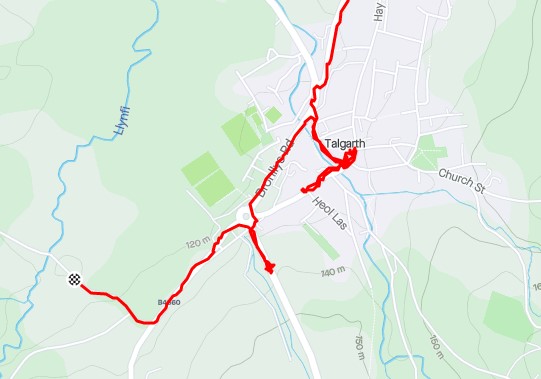
Later in the race I caught up with Andrew Nesbit who confirmed that when he passed me in the ditch I was sound asleep. He said that in his sleep deprived state, the flashing lights on my back caused him to think he had come across a car in a ditch until he got closer to me.
At 1:54am (according to Strava) I turned my watch off. It was at this stage that I decided I had finished the race. I didn’t think I could go any further. I restarted my watch at 2:51am.
I’m not sure what happened in between. Did I stop my watch then lie face down in a ditch and go to sleep. If so, the last kilometer before doing that had taken me 43 minutes. Or did I stop my watch after I woke up when I decided to drop out of the race. I don’t know.
My phone history shows that at 2:17am I rang Peter the meat wagon guy – the guy whose job it is to drive all over Wales collecting athletes when they can’t go on any further. I told him I had had enough and could he come and collect me. He told me to go back to Talgarth and wait for him, and my phone history shows that I rang him again at 2:33am to tell him I was now back in Talgarth.
While waiting for him I started to feel better and when he arrived to collect me I said that with only about 12 miles (20km) to go to the 200 mile checkpoint, I thought I should walk there and then reconsider my options at that stage. I apologised for not wanting to DNF and for dragging him out in the middle of the night, and started walking back towards my ditch again.
In total, about 3 hours had elapsed since I first arrived in Talgarth – remember that. Three hours. It becomes important later on.
The walk to checkpoint 8 at Llanfynnch turned out to be a little under 20km and took me about 3 ¾ hours. Not bad considering the mileage I had covered to date and the issues I had had in the previous few hours. Along the way I caught up with Andrew, walked with him for a while, and then continued ahead of him when he slowed down, arriving at checkpoint 8 about 20 minutes ahead of him. Other than an hour or so of rain, the walk was uneventful, and I was actually feeling pretty good.
Llanfynnch to Cardiff – 200 to 253 miles
I left the checkpoint at about 7am, 72 hours into the race, just as daylight was breaking. I needed my head torch for the first 15 minutes or so, but after that I could see my way clearly.
The next section was a 10 mile uphill climb from 200 metres above sea level to 500 metres and then, according to the guys at the checkpoint, it was all downhill to Cardiff!
The 15 mile climb went well. Andrew passed me early on and upon reaching the top Lindley Chambers and someone else were waiting with some food. I had heaps of food with me so I only took a banana , and started the ‘downhill to Cardiff’ section. I calculated that all I needed to do was walk 11 minutes and 40 seconds per kilometre for the next 64km – about 3.3 miles per hour. And with it all being downhill and a total elevation drop of 500 metres, that won’t be too difficult will it?
Five kilometres later and I was already five minutes behind schedule. This was anything but downhill all the way! Down for a bit then steep up again, then steep down. Not conducive to fast walking.
I decided to ignore my watch until we were off the steep section and nearer checkpoint 9 at Merthyr Tydfil – another place I had never been to but ‘knew’ like the back of my hand. Approaching Merthyr Tydfil we headed on to the Taff Trail which would take us all the way to Cardiff. Over and over again I ‘recognised’ the area and even ‘knew’ when we would be crossing the river or under/over the roads running alongside the trail.
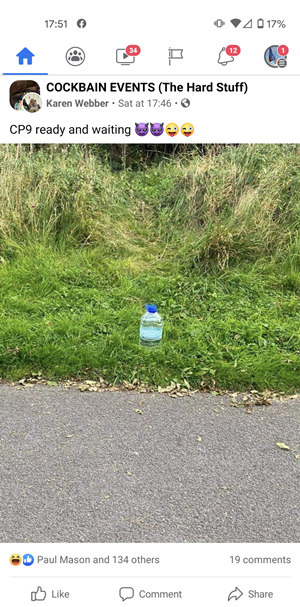
Checkpoint 9 was ‘basic’ like all the odd numbered checkpoints. In fact this one was probably the most basic – see photo – not even a chair to sit in for a short rest.
There was a McDonalds nearby but by now I had worked out that I needed to average exactly 11 minutes per kilometre for the remaining 46km (17 ½ minutes per mile for 28 ½ miles) and I was struggling to average 11:30, so no time to stop.
I asked one of the people at the checkpoint for Coke and they said they would arrange something and find me along the way somewhere – thanks to whoever that was even if you could only find Pepsi!
I tried as hard as I could but I really struggled to walk fast enough. 11 minutes per kilometre is about 17 ½ minutes per mile – about the speed that someone would casually walk to the shop. And I couldn’t hold that pace. It wasn’t physical. I put in a couple faster kilometres – in the low 9 minute range – but I couldn’t hold the pace.
Soon I found myself having imaginary conversations (arguments) between my mind and my body. My mind asked my body to go faster and my body responded by saying that we wouldn’t need to go faster if you (Mind) hadn’t gone ‘la la’ last night.
Another ‘conversation’ I remember was when my pace had managed to speed up a little and I imagined that my mind and body were now friends again and they were talking to me about how I had taken my feet for granted – “… You put your shoes and socks on 3 ½ days ago and haven’t looked at your feet since – you have taken them for granted …”
The conversations kept me entertained through to Pontypridd where I lost 28 minutes (according to Strava) walking 2km trying to find the correct route after finding the gate to the local park locked and not seeing the sign showing the after-hours diversion.
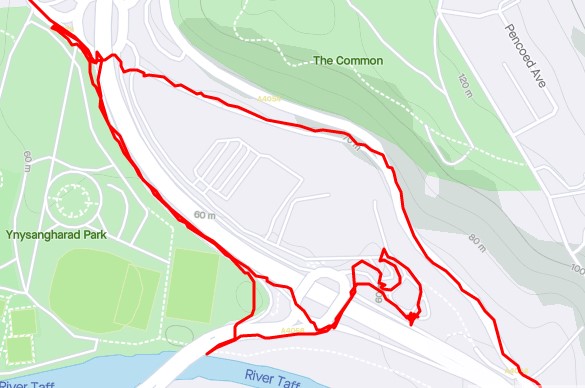
It was while I was wandering around trying to find the correct route that Gordon and Vic passed me. They had been over an hour behind me at checkpoint 9 about 12 miles earlier but they were focused on getting to the finish before 11pm – the race cut-off.
It was getting dark when I found my way back on to the correct route and I stopped for a few moments to put my head torch on. But where was my head torch? I couldn’t find it even after empty all the remaining contents of my backpack on to the ground. Fortunately, I had my spare head torch. But it wouldn’t turn on! The reason it is my spare head torch is that it isn’t 100% reliable but it has never not turned on.
I thought perhaps I had left my main head torch back at checkpoint 8. The only option was going to be to use my phone as a torch – how long would that last? And to walk as fast as I could and hopefully catch Gordon and Vic so that I could follow them with their head torches. The online tracker showed that they were only 1.2km ahead.
I put in a 9 minute kilometre. It was 8:30pm. There was about 20km to go. I calculated that I needed to walk 7 ½ minutes per kilometre to get to the finish by 11pm. Unlikely. The next kilometre was closer to 12 minutes followed by two more at 9 minutes each. There was no way I could go any faster than that and I wasn’t catching Gordon and Vic either.
And then I remembered that I had worn my head torch for the first few minutes after leaving checkpoint 8 earlier in the day. I felt the pocket of my jacket and there it was.
Suddenly the urgency to walk fast was gone. I had a head torch and I wasn’t going to get to Cardiff by 11pm, so why push it?
My pace immediately dropped and that was when the giants arrived. My mind started playing tricks on me again. Initially it was only occasionally that I would see a giant in front of me, and when I got nearer I would realise that the giant was actually just a tree.
Later on though, every tree was a giant – except for the trees that were actually huge bridges in the sky.
This went on for hours. I was tired and whenever I found a park bench or anything else I could sit on, I would stop and rest for a few moments. And when there weren’t giants and bridges, I felt like I had been here before. This time I ‘remembered’ being here on a school trip with my youngest son – who like me has never been to Wales other than to Cardiff city itself. More sleep deprived hallucinations and déjà vu.
I remember stopping and talking to two real people. On both occasions I asked them if they were real. I don’t know what they thought when asked that question – “Are you real?”.
Somewhere along the line I missed a turnoff over the river and followed what I thought was the proper route all the way through Bute Park and up to a big wooden locked gate. Thinking I was on the correct route, and with the river on my right I headed left looking for an exit from the park.
It was at this point that Karen Webber rang me. It was 12:30am and Karen and Peter (the meat wagon man) were waiting for me at the finish even although the race had officially finished 1 ½ hours ago. I explained my situation and apologised for taking so long, thanking Karen for waiting for me. I had assumed that I would finish the race alone, take a quick selfie finisher’s photo, and then walk to my hotel. It was nice to think that there would be someone at the finish to welcome me.
Karen suggested that I finish at the hotel rather than the Celtic Ring – the official race finish line – but I explained that I wanted to finish the official race even if I was late. I didn’t yet realise that I had gone off course.
As I was speaking to Karen I found an exit to the park and told Karen that “I will walk fast and see you soon”.
And then, just after hanging up on Karen I looked to my right and saw that I was walking beside a castle and thought to myself that “I don’t remember there being a castle in Adelaide”. Fortunately that was only a fleeting thought and I quickly remembered that I was in Cardiff, although I wasn’t sure how to get to the finish from where I was.
I opened Google Maps on my phone and typed in ‘Celtic Ring, Cardiff’. 1 ½ miles. 2 ½ kilometers.
The end was in sight and my pace picked up accordingly. 13 minutes, 11 minutes and then 10 minutes for the last kilometre.
I walked into the Celtic Ring and received a big hug from Karen – one of the biggest ultra-marathon fans around.
Karen took a photo for me and we walked the short distance to the hotel where Peter was waiting, having gone back to get me some warm clothes.
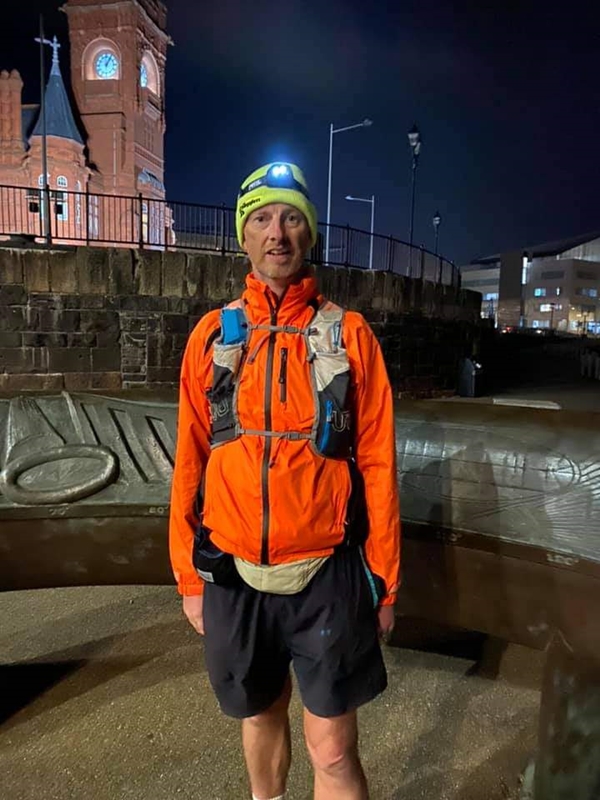
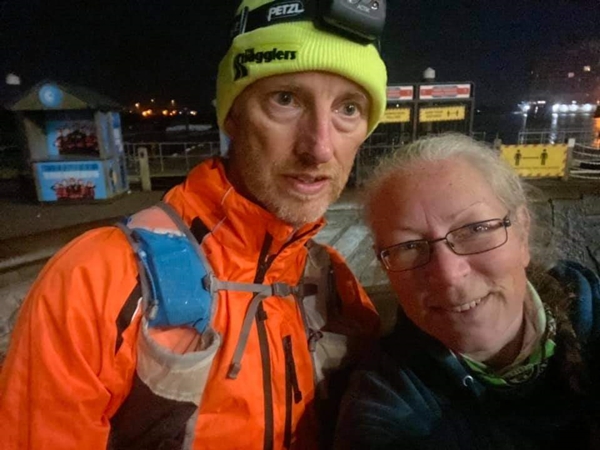
And that was my race. Holyhead to Cardiff in 90 hours and 5 minutes. 2 hours and 5 minutes too late to be an official finisher but 13th to cross the finish line out of 29 starters.
What ifs:
Could I have finished within the 88 hour cut-off? Absolutely. I lost three hours when I went ‘la la’ on Saturday night in Talgarth. If only I had simply stopped and had a 30 minute sleep.
I lost 30 minutes when I got lost in Pontypridd and 30 minutes on Friday night when I went the wrong way, although I gained about 30 minutes on Friday morning when I accidentally took a short-cut. In total I walked 420km according to my watch – an additional 13km (8 miles).

Will I try again?
NO!
My aim was to walk from Holyhead to Cardiff. I didn’t manage that in 2019. I did in 2021. It doesn’t matter to me that I took two hours longer than the race cut-off.
I have added a line across Wales to my ever-growing map of where I’ve walked, and I have other lines to add elsewhere.
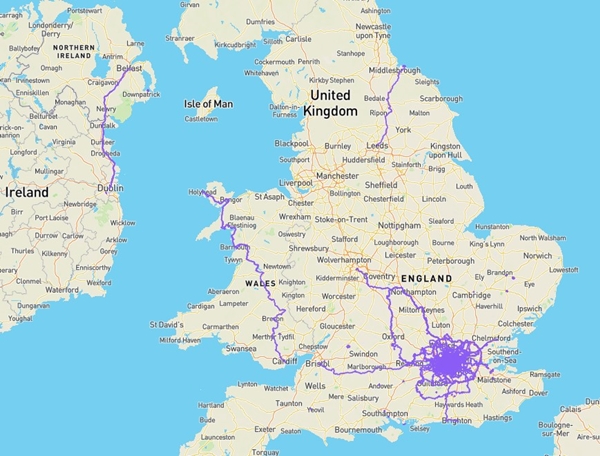
Congratulations to:
A couple people that I would like to congratulate:
- James Bassett
James finished first equal in 76 hours and 16 minutes together with Stephen Davies.
I first met James when he was a race-walker at the UK Centurion qualifying race in Bury St Edmonds in 2017. James qualified as UK Centurion 1175 in an impressive 21 hours 24 minutes that day but has since switched to running and had his best race to date at the Lon Las Ultra. James’ race report is here. - Tom Garrod
Tom was not in a very good condition when I caught him at checkpoint 3 early on Friday morning. But he bounced back and finished the race in 3rd place in 79 hours 32 minutes.
He then had a 20 hour rest before running back to the start, completing 506 miles in total in a little over nine days! - Steve Willis
I spent a reasonable amount of time with Steve on the Saturday and a little bit on the Friday as well. At one stage on the Saturday he told me he was thinking about dropping out. He didn’t, and went on to finish 9th in 85 hours 42 minutes. - Andrew Nesbit
I didn’t spend much time with Andrew. Only an hour or two in the early hours of Sunday morning. Andrew finished in 10th place in 87 hours and 11 minutes. - Gordon Hughes and Vic Owens
I didn’t spend any time with these two. I caught them some time before checkpoint two and they passed me at Pontypridd. Their finish time: 87 hours and 58 minutes!
I can’t imagine the mental pressure you two put on yourself to get to the finish before the 88 hour cut-off. Awesome! - Everyone else who started
Whether you finished or not, this is one very tough race. Congratulations on just being brave enough to start the race.
A big thank you:
Firstly to Karen and Peter for staying up to welcome me to the finish. It means a lot to me. Thanks.
Thanks also to Mark Cockbain for organising a great race, and to all the volunteers that helped us get from Holyhead to Cardiff.
Someone messaged me a few days after the race saying that Not all DNF’s are equal. I don’t know whether he was comparing his DNF to mine (Officially I am listed in the race results as a DNF because I didn’t finish within the 88 hours), or my 2019 DNF to my 2021 DNF. But thanks.
And thanks also to all the people who watched our dots moving across Wales of the race tracking website, sent us messages of support, commented on the Cockbain Events facebook page, etc. Knowing that we had your support helped when times were tough.
What’s Next?
For me it is the end of the year. I have struggled with niggly injuries since January and I’m now taking two months of complete rest to try and recover. I am seeing an Osteopath (thanks to medical insurance) and have joined a gym to work on my core strength and swim every second day.
At this stage my next race won’t be until May 2022 when I intend to smash my six day PB and hopefully become one of just six or seven race walkers to have walked 700km in an official six day walking race.
